
Jeff Meyers is the managing editor of
Concentrate, filterD and
Metromode. He is also a film critic for Detroit's
Metro Times and a Cable Commissioner for the city of Ann Arbor.
Born in Miami, raised in New York, educated in Illinois and schooled in the Pacific Northwest (Portland and Seattle), Jeff has a deep passion for both the arts and literature. He was producer of the 1996 National Poetry Slam (captured in the documentary
Slamnation), the Artistic Director of
Theatre Vertigo in Portland, a finalist for the 2000
Oregon Book Awards, the Creative Director for a video production start-up, a theater critic for Seattle's
The Stranger , an adjunct professor at both Clark College and Lewis and Clark College, and has been involved in numerous other creative endeavors.
Jeff lives in Ann Arbor's Burns Park with his wife Arden and his two sons. Once upon a time he was a microbiologist.
Posted By: Jeff Meyers
Posted: 8/26/2009
It was such a small thing that I didn't notice it at first. On a family vacation to Puerto Vallarta, as we were walking through the downtown my sons began weaving back and forth along the sidewalk. Why?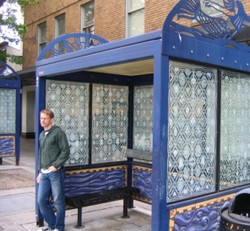 Stamped into the cement was a sine wave, a simple reminder of what mattered most to this small coastal city: The water. In Vancouver B.C., along Robson Street you'll find something similar. Only instead of a wave, small leaves have been imprinted into the sidewalk of a metropolis that thinks of itself as a leader in sustainable practices.
Stamped into the cement was a sine wave, a simple reminder of what mattered most to this small coastal city: The water. In Vancouver B.C., along Robson Street you'll find something similar. Only instead of a wave, small leaves have been imprinted into the sidewalk of a metropolis that thinks of itself as a leader in sustainable practices.
In various Seattle neighborhoods it isn't the sidewalk but the bus stands that boast the city's nautical identity. Gorgeously designed shelters are sculpted with iconic salmon, curly-cue waves and winged heron. The bus stands not only improve the surrounding streetscape, they also encourage you to rethink the importance of public transportation.
And this is just the tip of the iceberg for a city whose urban practices are idealized and livability celebrated. Public art inhabits every corner of Seattle. From its pastel-painted transformer stations adorned with ceramic sculptures to the two-story troll that resides under the Fremont Bridge to the Sound Garden (which inspired the rock band's name) that hums and whistles with the winds off Lake Washington to the newly installed Olympic Sculpture Garden near Pike's Place Market, creative expression is the norm.  Every neighborhood hides secret sculptures and quirky artifacts, inspiring locals to join the action with impromptu traffic circle displays and lawn art. And coupled with the region's high-tech persona, young creatives and professionals have flocked to the Pacific Northwest.
Every neighborhood hides secret sculptures and quirky artifacts, inspiring locals to join the action with impromptu traffic circle displays and lawn art. And coupled with the region's high-tech persona, young creatives and professionals have flocked to the Pacific Northwest.
Back to Puerto Vallarta, where wealth is in the hands of the few. The Malecón is a beachfront, open-air gallery of sculptures, ranging from the refined to the absurd. A sunset walk quickly demonstrates the enthusiasm tourists and locals have for the art (not to mention the children who climb all over them). The city, even with its limited resources and instances of crushing poverty, understands that there is lasting value in developing its artistic identity. When I ask a taxi driver what he thinks of the sculptures he smiles, "The tourists love them. The children love them. Some I don't like but mostly I love them."
So, what is Ann Arbor's artistic identity? What art can local cab drivers proudly proclaim their skeptical love for? The truth, if we are honest with ourselves, is that we don't have an artistic identity. Which is not to say that we don't have wonderful artists or interesting instances of art or dedicated art supporters. But as a community, we have yet to catch up with cities that have taken the long view and seen the cultural, economic, and quality of life advantages of nurturing an indigenous arts identity.
Even Ypsilanti, working with far fewer resources, has begun to stake out an arts identity of its own (see this week's feature article by Terry Parris), producing a do-it-yourself, alternative scene that excites young creatives and encourages artistic participation. 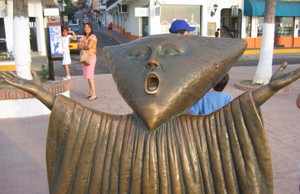 If you want a simple but poignant reminder of what a community one-fifth the size of Ann Arbor can achieve, just look to their Riverside Arts Gallery, which has become an arts and culture center of sorts, serving local visual and performing artists. Our city, for all its virtues, has yet to establish anything similar.
If you want a simple but poignant reminder of what a community one-fifth the size of Ann Arbor can achieve, just look to their Riverside Arts Gallery, which has become an arts and culture center of sorts, serving local visual and performing artists. Our city, for all its virtues, has yet to establish anything similar.
The closest thing Ann Arbor has come to establishing its own artistic identity has been the Art Fair (which is more about bringing art here) and the hand full of fairy doors that dot our downtown. We'll return to them later in the column.
City Council member Margie Teall, who sat on an Art Commission task force, shares the belief that Ann Arbor can and should do more. "I look at other cities, like Louisville, Kentucky, or Pittsburgh and I'm amazed by the public art they have and how far behind the eight ball we are," she says.
There are some, like Margaret Parker, who have long recognized the city's shortcomings on this front and have worked hard to change course. As the current chair of the city's Arts Commission, she helped usher i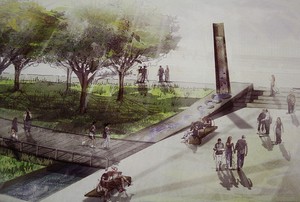 n the Percent For The Arts program in 2007, a long overdue first step toward formally engaging the city in developing its arts identity.
n the Percent For The Arts program in 2007, a long overdue first step toward formally engaging the city in developing its arts identity.
"People should remember that Michigan was once on the brink of a statewide Percent For The Arts program but it was killed by the Engler administration," Parker explains. "In a way we're trying to compensate for that loss of commitment."
And though Ann Arbor's current commission, still finding its feet, has taken some critical lumps on its first venture –the Herbert Dreiseitl rain garden that will be part of the new municipal center project— her passion and dedication are obvious.
"We're really new to this type of process and there's still so much to understand," Parker says. "We decided that it would be best to work out how we do this [fund public art projects] by focusing on a single project that was connected to the municipal center improvements."
It's an understandable course of action, one that focuses and compartmentalizes the commission's experience so it can better understand and develop its process.
But the commission need not go it alone, intellectually speaking. And it doesn't have to consult with faraway Seattle or Vancouver to work its approach. An hour away, a city with a long history of arts advocacy and practice nurtures a vibrant creative scene, implementing projects at every funding level and, most importantly, works off thirty-plus years of Percent For The Arts experience.
Though it may come as a surprise to most Ann Arborites, I'm talking about Toledo, Ohio, the first city east of the Mississippi to institute a Percent For The Arts program in 1977. In fact, the entire state of Ohio has a percent for the arts mandate, providing millions of dollars to local municipalities.
Talking with Marc Folk, executive director of the Arts Commission of Greater Toledo, it's easy to get swept up in his enthusiasm. He rattles off numbers and anecdotes and events and projects with a fervor that makes it clear he loves his job. What's most impressive is the creativity (imagine that, an arts organization that tackles its mission creatively) his organization brings to bear on Toledo's arts identity. The commission has its fingerprints on projects both big and small, nurturing strong artistic loops amidst rustbelt surroundings.
When the I-280 Bridge, the state's most expensive bridge project ever, first began its proposal process, the commission was on hand to influence the design, pulling in feedback from the community. As a result, more attractive stainless steel cables were used, glass panels were inserted into the pylons and L.E.D. lighting elements were incorporated. 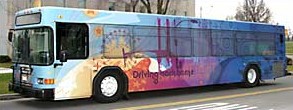 When a tragic accident took the lives of some of the bridge workers, the commission facilitated the construction of a memorial, drawing huge community support.
When a tragic accident took the lives of some of the bridge workers, the commission facilitated the construction of a memorial, drawing huge community support.
On the more modest end of the financial scale, the commission recruited at-risk youth to design benches inspired by masterworks in the Toledo Museum of Art, had a local auto fabricator make the benches, and then used them as a street level connect-the-dots between local galleries and the museum proper. Total cost of the project? $5000 plus staff time.
Somewhere in the economic middle is Toledo's program to put poetry inside and art outside its city buses. Working with TARTA and Bowling Green State University, the commission raised $40,000 to wrap 7-10 buses each year with stunning mobile canvases that bring art to the neighborhoods and poetry to the riders inside.
"Most art commissions get locked into old models, focusing on pieces that creatively engage the community," says Folk. "We try to make art an everyday part of Toledo life."
While Folk can wax poetic about the many projects his commission has been a part of (artistic manhole covers near Mud Hen's Arena), he believes his organization's biggest responsibility is to facilitate connections between the city's various arts groups and the community at large.
When asked about the arguments against public arts, particularly in economically challenging times, Folk points out that the same criticisms are levied in good times or bad. "The thing that I quickly learned is that public art, no matter which side people are on, stimulates public dialogue," he explains. "It pushes it into the public arena, which is a success unto itself."
As egalitarian as that sounds, Folk is quick to point out both the direct and indirect positive impacts of public art: "On a purely economic level, it is consistently cited as a major attractor for ideal professional candidates, i.e., creative thinkers and innovators."
The arguments against public art funding have always intrigued me because no one seems to get up in arms when the city builds a new baseball diamond or tennis court. But spend money on an unconventional statue or mural and watch the fireworks fly. It seems silly that one holds more intrinsic value than another. If anything, I would argue a sports field in one community is no different than a sports field in another. Public art, at least, can be unique and defining.  But really, the two investments are equally important, inviting the public to interact --one physically, the other intellectually.
But really, the two investments are equally important, inviting the public to interact --one physically, the other intellectually.
Which brings us back to the Fairy Doors and how Ann Arbor might forge its own artistic identity.
It's baffling to me that these charming little doors --a modest, private effort that attracts local tourists and even landed national press coverage-- receives so little public support, beyond endorsements from the city's Convention And Visitor's Bureau. It's not that the fairy doors are great works of art, it's that they clearly engage the community, making a strong case for why public arts efforts are important.
Were these doors to have 'magically' appeared in my old stomping grounds of Seattle, I can easily imagine the city enthusiastically funding the project to facilitate a greater presence in the community. Local artists would have inevitably responded, some in protest no doubt, creating contrarian goblin doors or even dead fairy art, and the like. The effort would have become a robust artistic dialogue to debate the goals of public art, what is of aesthetic value, what amounts to cheap gimmickry, and all points in between.
Do I think we should build our entire artistic identity around fairy doors? Certainly not. But they could certainly be a part of a wider, richer fabric of artistic engagement. And whether we choose to support efforts like these speaks to how we leverage the creativity that exists in our community, and to what lengths we will nurture its growth.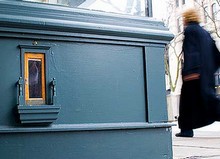 A modest investment might have turned an independent project into a widespread entry point for Ann Arbor's children to engage with public art (not to mention, establish a useful community marketing tool).
A modest investment might have turned an independent project into a widespread entry point for Ann Arbor's children to engage with public art (not to mention, establish a useful community marketing tool).
As the Ann Arbor Arts Commission looks to its future, I can only hope that it will learn from cities like Toledo and Seattle and even cash-strapped Puerto Vallarta for inspiration, creating programs that are as creative, versatile, and innovative as the works of art they generate.
Photo Credits:
Seattle Bus Shelter - Jeff Meyers
La Nostalgia by Ramiz Barquet , Puerto Vallarta - Jeff Meyers
Edge Of Reason by Sergio Bustamente, Puerto Vallarta - Jeff Meyers
Artist rendering of Herbert Dreiseitl's proposed water sculpture
I-280 Bridge, Toledo - Wikipedia
TARTA bus wrap - TARTA website
The Fremont Troll, Seattle - Jeff Meyers
Garth Edwards Manhole Cover, Seattle - City Of Seattle website
Fairy Door, Ann Arbor - Myra Klarman